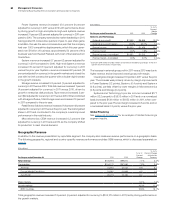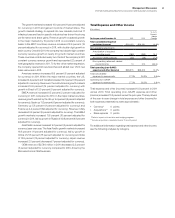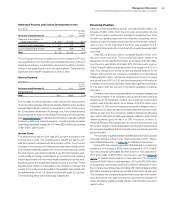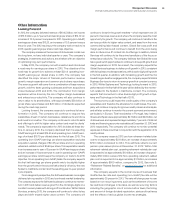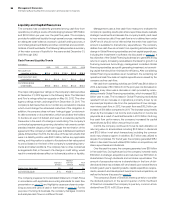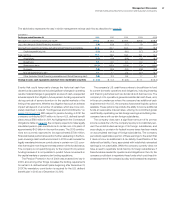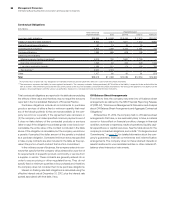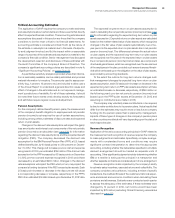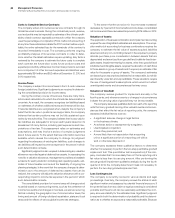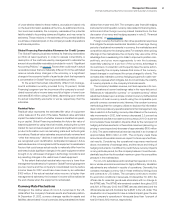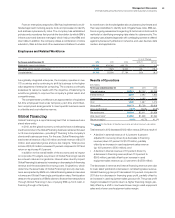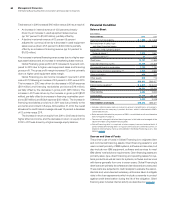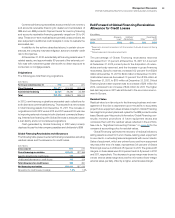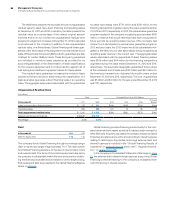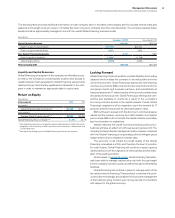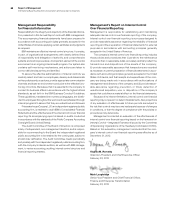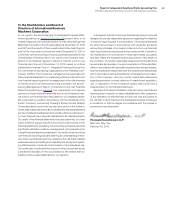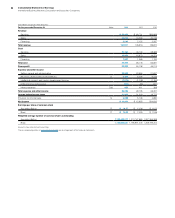IBM 2012 Annual Report Download - page 61
Download and view the complete annual report
Please find page 61 of the 2012 IBM annual report below. You can navigate through the pages in the report by either clicking on the pages listed below, or by using the keyword search tool below to find specific information within the annual report.6060 Management Discussion
International Business Machines Corporation and Subsidiary Companies
Costs to Complete Service Contracts
The company enters into numerous service contracts through its
Global Services business. During the contractual period, revenue,
cost and profits may be impacted by estimates of the ultimate profit-
ability of each contract, especially contracts for which the company
uses the percentage-of-completion (POC) method of accounting. If
at any time these estimates indicate the POC contract will be unprof-
itable, the entire estimated loss for the remainder of the contract is
recorded immediately in cost. The company performs ongoing
profitability analyses of its services contracts in order to deter-
mine whether the latest estimates require updating. Key factors
reviewed by the company to estimate the future costs to complete
each contract are future labor costs, future product costs and
expected productivity efficiencies. Contract loss provisions recorded
as a component of other accrued expenses and liabilities were
approximately $54 million and $52 million at December 31, 2012 and
2011, respectively.
Income Taxes
The company is subject to income taxes in the U.S. and numerous
foreign jurisdictions. Significant judgments are required in determin-
ing the consolidated provision for income taxes.
During the ordinary course of business, there are many trans-
actions and calculations for which the ultimate tax determination is
uncertain. As a result, the company recognizes tax liabilities based
on estimates of whether additional taxes and interest will be due.
These tax liabilities are recognized when, despite the company’s
belief that its tax return positions are supportable, the company
believes that certain positions may not be fully sustained upon
review by tax authorities. The company believes that its accruals for
tax liabilities are adequate for all open audit years based on its
assessment of many factors, including past experience and inter-
pretations of tax law. This assessment relies on estimates and
assumptions, and may involve a series of complex judgments
about future events. To the extent that new information becomes
available which causes the company to change its judgment
regarding the adequacy of existing tax liabilities, such changes to
tax liabilities will impact income tax expense in the period in which
such determination is made.
Significant judgment is also required in determining any valuation
allowance recorded against deferred tax assets. In assessing the
need for a valuation allowance, management considers all available
evidence for each jurisdiction including past operating results, esti-
mates of future taxable income and the feasibility of ongoing tax
planning strategies. In the event that the company changes its deter-
mination as to the amount of deferred tax assets that can be
realized, the company will adjust its valuation allowance with a cor-
responding impact to income tax expense in the period in which
such determination is made.
The consolidated provision for income taxes will change period
to period based on nonrecurring events, such as the settlement of
income tax audits and changes in tax laws, as well as recurring
factors including the geographic mix of income before taxes, the
timing and amount of foreign dividend repatriation, state and local
taxes and the effects of various global income tax strategies.
To the extent that the provision for income taxes increases/
decreases by 1 percent of income before income taxes, consolidated
net income would have decreased/improved by $219 million in 2012.
Valuation of Assets
The application of business combination and impairment accounting
requires the use of significant estimates and assumptions. The acqui-
sition method of accounting for business combinations requires the
company to estimate the fair value of assets acquired, liabilities
assumed, and any non-controlling interest in the acquiree to properly
allocate purchase price consideration between assets that are
depreciated and amortized from goodwill and indefinite-lived intan-
gible assets. Impairment testing for assets, other than goodwill and
indefinite-lived intangible assets, requires the allocation of cash flows
to those assets or group of assets and if required, an estimate of fair
value for the assets or group of assets. The company’s estimates
are based upon assumptions believed to be reasonable, but which
are inherently uncertain and unpredictable. These valuations require
the use of management’s assumptions, which would not reflect
unanticipated events and circumstances that may occur.
Valuation of Goodwill
The company reviews goodwill for impairment annually, in the
fourth quarter, and whenever events or changes in circumstances
indicate the carrying value of goodwill may not be recoverable.
The company assesses qualitative factors in each of its reporting
units that carry goodwill. Among other relevant events and circum-
stances that affect the fair value of reporting units, the company
assesses individual factors such as:
• A significant adverse change in legal factors
or the business climate;
• An adverse action or assessment by a regulator;
• Unanticipated competition;
• A loss of key personnel; and
• A more likely than not expectation that a reporting
unit or a significant portion of a reporting unit will be
sold or otherwise disposed of.
The company assesses these qualitative factors to determine
whether it is necessary to perform the two-step quantitative goodwill
impairment test. This quantitative test is required only if the com-
pany concludes that it is more likely than not that a reporting unit’s
fair value is less than its carrying amount. After performing the
annual goodwill impairment qualitative analysis during the fourth
quarter of 2012, the company determined it was not necessary to
perform the two-step goodwill impairment test.
Loss Contingencies
The company is currently involved in various claims and legal
proceedings. Quarterly, the company reviews the status of each
significant matter and assesses its potential financial exposure. If
the potential loss from any claim or legal proceeding is considered
probable and the amount can be reasonably estimated, the com-
pany accrues a liability for the estimated loss. Significant judgment
is required in both the determination of probability and the determi-
nation as to whether an exposure is reasonably estimable. Because


